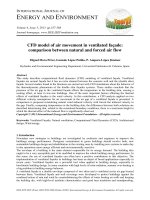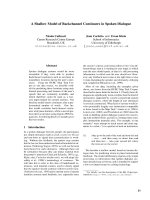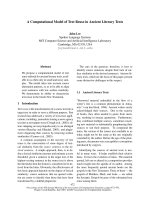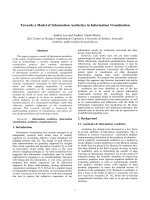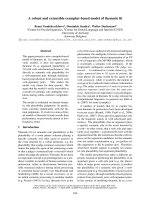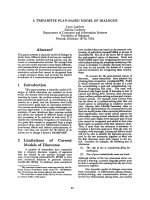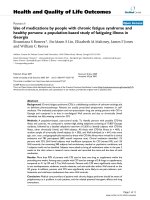Agent based model of passenger flows in airport terminals
Bạn đang xem bản rút gọn của tài liệu. Xem và tải ngay bản đầy đủ của tài liệu tại đây (3.86 MB, 229 trang )
AGENT-BASED MODEL OF PASSENGER
FLOWS IN AIRPORT TERMINALS
A THESIS SUBMITTED TO
THE SCIENCE AND ENGINEERING FACULTY
OF QUEENSLAND
UNIVERSITY OF TECHNOLOGY
IN FULFILMENT OF THE REQUIREMENT FOR THE DEGREE OF
DOCTOR OF PHILOSOPHY
Wenbo Ma
Science and Engineering Faculty
Queensland University of Technology
2012
ii
Statement of Original Authorship
The work contained in this thesis has not been previously submitted to meet
requirements for an award at this or any other higher education institution. To the
best of my knowledge and belief, the thesis contains no material previously
published or written by another person except where due reference is made.
Signature:
Date:
13th June, 2013
iii
iv
Dedicated to my parents, Jiqin Ma and Ping Jiang
v
vi
Keywords
Agent-based model; simulation; airport; pedestrian flow; agent decision-making;
Bayesian networks; influence diagram; routing decisions; route-choice decision-making.
vii
Abstract
Passenger flow studies in airport terminals have shown consistent statistical
relationships between airport spatial layout and pedestrian movement, facilitating
prediction of movement from terminal designs. However, these studies are done at an
aggregate level and do not incorporate how individual passengers make decisions at
a microscopic level. Therefore, they do not explain the formation of complex
movement flows. In addition, existing models mostly focus on standard airport
processing procedures such as immigration and security, but seldom consider
discretionary activities of passengers, and thus are not able to truly describe the full
range of passenger flows within airport terminals. As the route-choice decisionmaking of passengers involves many uncertain factors within the airport terminals,
the mechanisms to fulfil the capacity of managing the route-choice have proven
difficult to acquire and quantify.
Could the study of cognitive factors of passengers (i.e. human mental
preferences of deciding which on-airport facility to use) be useful to tackle these
issues? Assuming the movement in virtual simulated environments can be analogous
to movement in real environments, passenger behaviour dynamics can be similar to
those generated in virtual experiments. Three levels of dynamics have been devised
for motion control: the localised field, tactical level, and strategic level. A localised
field refers to basic motion capabilities, such as walking speed, direction and
avoidance of obstacles. The other two fields represent cognitive route-choice
decision-making. This research views passenger flow problems via a “bottom-up
approach”, regarding individual passengers as independent intelligent agents who
can behave autonomously and are able to interact with others and the ambient
environment. In this regard, passenger flow formation becomes an emergent
phenomenon of large numbers of passengers interacting with others.
In the thesis, first, the passenger flow in airport terminals was investigated.
Discretionary activities of passengers were integrated with standard processing
procedures in the research. The localised field for passenger motion dynamics was
constructed by a devised force-based model. Next, advanced traits of passengers
(such as their desire to shop, their comfort with technology and their willingness to
viii
ask for assistance) were formulated to facilitate tactical route-choice decisionmaking. The traits consist of quantified measures of mental preferences of
passengers when they travel through airport terminals. Each category of the traits
indicates a decision which passengers may take. They were inferred through a
Bayesian network model by analysing the probabilities based on currently available
data. Route-choice decision-making was finalised by calculating corresponding
utility results based on those probabilities observed.
Three sorts of simulation outcomes were generated: namely, queuing length
before checkpoints, average dwell time of passengers at service facilities, and
instantaneous space utilisation. Queuing length reflects the number of passengers
who are in a queue. Long queues no doubt cause significant delay in processing
procedures. The dwell time of each passenger agent at the service facilities were
recorded. The overall dwell time of passenger agents at typical facility areas were
analysed so as to demonstrate portions of utilisation in the temporal aspect. For the
spatial aspect, the number of passenger agents who were dwelling within specific
terminal areas can be used to estimate service rates. All outcomes demonstrated
specific results by typical simulated passenger flows. They directly reflect terminal
capacity. The simulation results strongly suggest that integrating discretionary
activities of passengers makes the passenger flows more intuitive, observing
probabilities of mental preferences by inferring advanced traits make up an approach
capable of carrying out tactical route-choice decision-making.
On the whole, the research studied passenger flows in airport terminals by an
agent-based model, which investigated individual characteristics of passengers and
their impact on psychological route-choice decisions of passengers. Finally, intuitive
passenger flows in airport terminals were able to be realised in simulation.
ix
List of Publications
Journal article
Wenbo Ma, Tristan Kleinschmidt, Clinton Fookes and Prasad K.D.V.
Yarlagadda, “Micro-simulation of airport passengers with advanced traits: a
case study of Brisbane Airport international departure terminal”, Simulation
Modelling Practice and Theory (Under review)
Wenbo Ma, Tristan Kleinschmidt, Clinton Fookes and Prasad K.D.V.
Yarlagadda, “A review: Pedestrian dynamics in the real and simulated world”,
Journal of Urban Planning and Development (To be submitted)
Peer-reviewed conference papers
Wenbo Ma, Tristan Kleinschmidt, Clinton Fookes and Prasad K.D.V.
Yarlagadda, (2011) Check-in processing: simulation of passengers with
advanced traits. In Fu, Michael & White, K. Preston (Eds.) Proceedings of the
2011 Winter Simulation Conference, pp. 1783-1794, IEEE, Phoenix, AZ,
USA.
Tristan Kleinschmidt, Xufeng Guo, Wenbo Ma, and Prasad K.D.V.
Yarlagadda (2011) Including airport duty-free shopping in arriving passenger
simulation and the opportunities this presents. In Jain, S., Creasey, R. R.,
Himmelspach, J., White, K.P., &Fu, M. (Eds.) Proceedings of the 2011
Winter Simulation Conference, pp. 210-221, IEEE, Phoenix, AZ, USA.
Wenbo Ma, Tristan Kleinschmidt, Clinton Fookes and Prasad K.D.V.
Yarlagadda, (2012) Modelling Passengers Flow at Airport Terminals Individual Agent Decision Model for Stochastic Passenger Behaviour.
Proceedings of the 2th International Conference on Simulation and Modelling
Methodologies, Technologies and Applications, pp.109-113, Rome, Italy.
Wenbo Ma, Tristan Kleinschmidt, Clinton Fookes and Prasad K.D.V.
Yarlagadda, (2012) A micro-simulation of airport passengers with advanced
traits. Proceedings of 28th International Congress of Aeronautical Society,
ICAS 2012 - 10.9.4, Brisbane, Australia.
x
Wenbo Ma, Prasad K.D.V. Yarlagadda and Clinton Fookes, (2012) Using
advanced traits of passengers to facilitate route-choice decision-making. To
be presented
in
Proceedings
of 4th
International
Computational Methods (ICCM), Gold Coast, Australia.
xi
Conference
on
Table of Contents
Keywords ................................................................................................................... vii
Abstract ..................................................................................................................... viii
List of Publications....................................................................................................... x
Table of Contents ....................................................................................................... xii
List of Figures ........................................................................................................... xvi
List of Tables ............................................................................................................. xix
List of Abbreviations .................................................................................................. xx
Acknowledgments ..................................................................................................... xxi
1 CHAPTER 1: INTRODUCTION
1
1.1 Background and Motivation .................................................................................. 2
1.1.1 Passenger activities in airport terminals .................................................... 3
1.1.2 Pedestrian movement and behaviours ....................................................... 4
1.1.3 Solution for passenger dynamics ............................................................... 5
1.2 Research problem .................................................................................................. 7
1.3 Research objectives ............................................................................................... 8
1.4 Statement of Contribution ................................................................................... 10
1.5 Outline of the Thesis ........................................................................................... 11
2 CHAPTER 2:
PEDESTRIAN DYNAMICS IN THE REAL AND
SIMULATED WORLD
14
2.1 Introduction ......................................................................................................... 15
2.2 Macroscopic Models ........................................................................................... 18
2.2.1 Physical characteristics of pedestrians .................................................... 20
2.2.2 Routing dynamics of pedestrians ............................................................ 21
2.2.3 Limitation of macroscopic models .......................................................... 24
2.3 Microscopic Models ............................................................................................ 25
2.3.1 Micro models of pedestrian dynamics..................................................... 26
2.3.2 Social force model ................................................................................... 29
2.3.3 Tactical routing models ........................................................................... 33
2.3.4 Agent-based pedestrian models ............................................................... 35
2.4 Agent-based modelling and simulation ............................................................... 37
2.4.1 Agent ....................................................................................................... 37
2.4.2 Agent-based model .................................................................................. 39
xii
2.4.3 Applications of Agent-Based Simulation................................................ 42
2.5 Pedestrian flow Simulation ................................................................................. 45
2.5.1 Models and simulation ............................................................................ 45
2.5.2 Conduct simulation study ........................................................................ 48
2.5.3 Measurement and control of pedestrian interaction ................................ 51
2.5.4 Pedestrian flow validation ....................................................................... 53
2.6 Chapter summary ................................................................................................ 54
3 CHAPTER 3: AIRPORT CHARACTERISTICS AND ADVANCED TRAITS
OF AIR PASSENGERS
57
3.1 Overview of airport passenger flows .................................................................. 58
3.1.1 Departing passengers............................................................................... 60
3.1.2 Arriving passengers ................................................................................. 62
3.1.3 Other forms of passenger flows .............................................................. 63
3.2 Simulation as a tool to model airportS ................................................................ 64
3.2.1 Overview of airport landside simulation ................................................. 65
3.2.2 Significance of modelling airport system................................................ 69
3.3 Air passenger characteristics ............................................................................... 72
3.3.1 Basic traits of air passenger..................................................................... 74
3.4 Advanced passenger characteristics .................................................................... 75
3.5 Chapter summary ................................................................................................ 79
4 CHAPTER 4: INCLUDING DISCRETIONARY ACTIVITIES IN AIRPORT
SIMULATION
81
4.1 Inplementation of discretionary activities ........................................................... 82
4.2 Simulation of passengers with advanced traits ................................................... 85
4.2.1 Advanced passenger characteristics for check-in.................................... 86
4.2.2 Check-in processing simulation .............................................................. 88
4.2.3 Setting up simulation............................................................................... 90
4.2.4 Results of simulation and analysis .......................................................... 92
4.3 Chapter summary ................................................................................................ 96
5 CHAPTER 5: APPROACHES FOR MEANINGFUL PASSENGER FLOW
SIMULATION
98
5.1 Outline of the passenger flow simulation ........................................................... 99
5.2 Constant states of passengers ............................................................................ 100
5.2.1 Spatial criteria ....................................................................................... 100
5.2.2 Temporal criteria ................................................................................... 103
5.3 Interaction dynamics of passengers .................................................................. 104
xiii
5.3.1 Walking model with physical meaning ................................................. 105
5.3.2 Theory of route-choice decision making ............................................... 110
5.3.3 Devise graphical model ......................................................................... 112
5.3.4 Utilities and decisions ........................................................................... 115
5.4 Chapter summary .............................................................................................. 116
6 CHAPTER 6:
AGENTS
TACTICAL ROUTING CHOICES OF PASSENGER
118
6.1 Decision-making strategy of passengers ........................................................... 119
6.1.1 Key behaviours of passengers in airport ............................................... 120
6.1.2 Agent decisions ..................................................................................... 120
6.2 Overview of passenger agent decision-making ................................................. 122
6.2.1 Categories of air passengers .................................................................. 124
6.2.2 Bayesian network decision-making approach ....................................... 128
6.2.3 Influence diagram of agent decision-making ........................................ 130
6.3 Case study ......................................................................................................... 134
6.4 Chapter summary .............................................................................................. 141
7 CHAPTER 7:
ANALYSIS
PASSENGER FLOW SIMULATION OUTPUTS AND
143
7.1 Passenger flows on condition of a single scheduled flight................................ 144
7.1.1 Simulation overview.............................................................................. 145
7.1.2 Simulation set-up ................................................................................... 149
7.1.3 Simulation analysis................................................................................ 154
7.2 A full-day simulation of passenger flows ......................................................... 157
7.2.1 Simulation overview.............................................................................. 158
7.2.2 Simulation set-up ................................................................................... 162
7.2.3 Simulation analysis................................................................................ 165
7.3 Simulation of passenger flows in abnormal conditionS .................................... 170
7.3.1 Simulation set-up ................................................................................... 170
7.3.2 Simulation analysis................................................................................ 171
7.4 Chapter summary .............................................................................................. 173
8 CHAPTER 8: DISCUSSION AND CONCLUSION
174
8.1 Summary and discussion ................................................................................... 174
8.1.1 Research summary ................................................................................ 176
8.1.2 Passenger flow validation discussion .................................................... 177
8.2 Research contributions ...................................................................................... 179
8.3 Recommendations ............................................................................................. 180
xiv
BIBLIOGRAPHY
184
APPENDICES
196
Appendix A: Bayesian Networks ................................................................... 196
Appendix B: Influence Diagram ..................................................................... 198
Appendix C: Parameters for Simulation ......................................................... 202
Appendix D: Complementary Figures for Outbound Passenger flows
Simulation ............................................................................................. 204
xv
List of Figures
Figure 2-1: Pedestrian movement research fields ...................................................... 16
Figure 2-2: People flow equation (Lovas, 1994)........................................................ 19
Figure 2-3: Graph of people flow density (Hankin & Wright, 1958) ........................ 19
Figure 2-4: Illustration of pedestrians evacuating a fixed wide exit (Helbing &
Molnar, 1995) ..................................................................................................... 20
Figure 2-5: Pedestrian walking speed and density (M ri and Tsukaguchi, 1987) ..... 22
Figure 2-6: Current pedestrian walking models ......................................................... 26
Figure 2-7: The social force model ............................................................................ 31
Figure 2-8: Structure of a typical agent-based model (Epstein and Axtell, 1996) ..... 38
Figure 2-9: Agent-based modelling software (Macal and North, 2006) .................... 43
Figure 3-1: Domestic terminal ................................................................................... 59
Figure 3-2: International terminal .............................................................................. 60
Figure 3-3: Departing passenger processing procedures............................................ 61
Figure 3-4: Arriving passenger processing procedures .............................................. 62
Figure 3-5: Transferring passenger processing procedures ........................................ 63
Figure 3-6: Overview of air passenger flow taxonomy.............................................. 66
Figure 3-7: Whole-of-airport model showing complicated behaviours outside the
mandatory process .............................................................................................. 72
Figure 3-8: Relationship between airport ancillary facilities and the activities that
passengers undertake .......................................................................................... 76
Figure 4-1: International passenger arrivals process common to Australian airports 82
Figure 4-2: International passenger departure process common to Australian airports83
Figure 4-3: Spatial layout for hypothetical check-in case study ................................ 88
Figure 4-4: Decision flowchart to demonstrate the use of advanced passenger
characteristics ...................................................................................................... 89
Figure 4-5: Membership functions used in simulations ............................................. 91
Figure 4-6: Departing passenger arrival schedule for a single flight ......................... 92
Figure 4-7: Utilisation of check-in, SSK, café, phone booth and information desk .. 93
Figure 4-8: Comparisons of instantaneous utilisation of departure hall .................... 93
Figure 4-9: Comparisons of instantaneous utilisation of overall dwell time ............. 94
Figure 4-10: Check-in utilisation for the three simulation scenarios ......................... 95
Figure 4-11: Demonstration of variation of comfort with technology on SSK
utilisation............................................................................................................. 96
xvi
Figure 5-1: Scenario comparisons of Levels C and E of IATA LOS Space Standards
(de Neufville, 2003) .......................................................................................... 101
Figure 5-2: Level of service diagram for passenger flows (de Neufville, 2003) ..... 103
Figure 5-3: Illustration of destination-choice of passengers in the force model ...... 106
Figure 5-4: Screenshot of the force-based model simulation................................... 109
Figure 5-5: Schematic representation of processes leading to route-choice decisions110
Figure 5-6: Outbound passenger flowchart .............................................................. 111
Figure 5-7: Bayesian networks of usage of self-service facilities............................ 113
Figure 6-1: Framework of agent-decision model ..................................................... 123
Figure 6-2: Decision tree of the general structure of experimental decisions ......... 126
Figure 6-3: State and inference model for passenger agent discretionary activity
decision-making ................................................................................................ 127
Figure 6-4: Influence diagram .................................................................................. 131
Figure 6-5: Influence diagram for selecting a decision with highest expected utility133
Figure 6-6: A decision is made by the influence diagram when entering check-in hall136
Figure 6-7 The decision made by the influence diagram after Food Court ............. 137
Figure 6-8: Sequential target and route choices of the passenger agent .................. 138
Figure 6-9: The decision made by the influence diagram once Time Stress changes
value .................................................................................................................. 139
Figure 6-10: A decision is made by the influence diagram when arriving at airside
portion of the terminal ...................................................................................... 140
Figure 7-1: Layout of the airport’s departure terminal ............................................ 145
Figure 7-2: Membership functions used in simulations ........................................... 148
Figure 7-3 Model framework ................................................................................... 150
Figure 7-4: Departing passenger arrival schedule for a single flight ....................... 152
Figure 7-5: Simulation environment (check-in hall part) ........................................ 153
Figure 7-6: Instantaneous utilisation of check-in counters ...................................... 154
Figure 7-7: Instantaneous utilisation of security and immigration and time spent at
security and immigration counters .................................................................... 155
Figure 7-8: Instantaneous usage of discretionary facilities and time spent in food
facilities............................................................................................................. 156
Figure 7-9: Overall layout of the simulation ............................................................ 158
Figure 7-10: Structure of the passenger class .......................................................... 160
Figure 7-11: Bayesian networks graph .................................................................... 161
Figure 7-12: Conditional probabilities of advanced traits........................................ 163
Figure 7-13: Illustration of route choice at a decision point .................................... 164
Figure 7-14: Dwell time statistics of standard processing procedures ..................... 165
xvii
Figure 7-15: Time statistics of standard processing procedures .............................. 166
Figure 7-16: Dwell time statistics of discretionary activities ................................... 166
Figure 7-17: Illustration of service utilisation .......................................................... 167
Figure 7-18: Illustration of queue length.................................................................. 168
Figure 7-19: Illustration of security ......................................................................... 169
Figure 7-20: Animation of passenger flow in the abnormal conditions ................... 171
Figure 7-21: Discretionary dwell time due to abnormal conditions......................... 172
xviii
List of Tables
Table 2-1: Comparison of microscopic pedestrian simulation models ...................... 29
Table 2-2: Comparison of system dynamics, discrete-event and agent-based
simulation ........................................................................................................... 41
Table 2-3: Comparison of agent-based modelling toolkits ........................................ 44
Table 3-1: Comparison of macroscopic passenger flow simulation tools ................. 69
Table 3-2: Basic factors which affect passenger mobility and path selection ........... 75
Table 3-3: Discretionary behaviours .......................................................................... 78
Table 4-1: Impact of utilising retail for passenger clearance times through
international arrivals in Australia ....................................................................... 84
Table 4-2: Advanced passenger characteristics proposed for check-in area.............. 87
Table 5-1: IATA LOS Space Standards for airport passenger terminal based on busy
hour (m /pax) (IATA LOS Space Standards, old version: Airport Development
Manual, 8th ed., 1995) ...................................................................................... 101
Table 5-2: IATA LOS Space Standards (New version: Airport Development Manual,
9th ed., 2004) .................................................................................................... 102
Table 5-3: Flow standards ........................................................................................ 103
Table 5-4: Average dwell time that passengers spend at standard checkpoints and
ancillary facilities.............................................................................................. 104
Table 5-5 Numberical parameters for a simulation of the force model ................... 108
Table 6-1: Categories of air passengers ................................................................... 125
Table 6-2 Conditional probability table for the node “Comfort of Technology” .... 129
Table 6-3: Priority values for the five actions .......................................................... 134
Table 6-4: Basic traits for the passenger agent in Scenario 1 .................................. 135
Table 6-5: Basic traits for the passenger agent in Scenario 2 .................................. 141
Table 7-1: Examples of advanced passenger characteristics proposed for outbound
passenger flows ................................................................................................. 147
Table 7-2: Planned dwell time that passengers spend at ancillary facilities ............ 151
Table 7-3: Selected advanced traits of passengers ................................................... 162
xix
List of Abbreviations
ABM
Agent-based Model
ABS
Agent-based Simulation
AI
Artificial Intelligence
ATM
Automatic Teller Machines
BDI
Belief-desire-intension
CA
Cellular Automata
CPD
Conditional Probability Distribution
CPT
Conditional Probability Tables
DES
Discrete-Event Simulation
ECP
Entry Control Point
IATA
International Air Transport Association
KPI
Key Performance Indicators
LOS
Level of Service
MCDM
Multi-criteria decision making
OAV
Object-attribute-value
PMM
Persons Meter/Minute
PQA
Pedestrian Quality Attribute
SD
System Dynamics
SFM
Social Force Model
SSK
Self-Service Kiosks
xx
Acknowledgments
I would like to thank Professor Prasad Yarlagadda for his advice and guidance
throughout the course of this thesis. Thanks are also due to Associate Professor
Clinton Fookes and Dr. Tristan Kleinschmidt for their valuable advice on my
research and assistance in proofreading my papers, and to many colleagues who have
contributed to this research.
I appreciate the financial support from Queensland University of Technology,
China Scholarship Council, and the Airports of the Future project. With their
generous support, I was able to concentrate on my PhD study without any financial
distractions.
I thank the Airports of the Future project for providing a great platform to pursue
collaboration among different disciplines, industry and government departments. My
thanks are also due to the Brisbane Airport Corporation for permission to access their
data to facilitate the simulation practice.
Lastly, thanks to all the people who have encouraged and helped me in my
study, but who are not named here.
xxi
Chapter 1: Introduction
1
The study presented in this thesis explores a new scope of modelling pedestrian
flows in built environments. In particular, it investigates real scenarios of passenger
flows in airport terminals. On the one hand, regulation policies and terminal layouts
often change due to air transportation growth, security concerns and implementation
of new technologies. As a result, the routes and patterns of passenger flows will
change accordingly. On the other hand, standard processing facilities (such as checkin, security, immigration, customs, boarding, bag reclaim) and on-airport
discretionary facilities (such as duty-free shops, restaurants and cafés, phone booths,
Internet access, PC desks) are simultaneously used by passengers. Simply
considering passengers through standard processing procedures does not seem to be
comprehensive. So as to attain a realistic full-scale model of passenger flows, both
the standard processing and discretionary types of activities are analysed in the study.
In airport terminals, passengers are considered to have strong cognitive ability.
They watch and explore the environment within airport terminals and process wayfinding information in the psychological aspect. This should be an approach to
1
2
Chapter 1: Introduction
realise the route-choice decision-making of passengers. In this regard, a passenger is
assumed to be an agent who is able to autonomously choose a direction and walk
towards the next target. Such an agent-based model is utilised to tackle large
numbers of passengers and study emergent outcomes of the formation of passenger
flows in macroscopic detail. The agents within the proposed agent-based model
could represent both passengers and on-airport facilities. Pedestrian localised
dynamics are studied to cope with passenger motion. Advanced traits of passengers
are devised in light of the cognitive preferences of passengers inside an airport
terminal. Route-choice decision-making of passengers is executed by the devised
agent decision-making module.
The background and motivation for this project is presented in Section 1.1.
Section 1.2 sets out the research problems. The objectives are provided in Section 1.3
and the statement of contribution is presented in Section 1.4. The chapter concludes
with an outline of the thesis structure in Section 1.5.
1.1 BACKGROUND AND MOTIVATION
The Australian airline industry is growing at a very high speed (National Aviation
Policy White Paper, Australian Government, 2009). The role in transportation of
people and goods served by airports has become much more important in the modern
world. Due to the large growth of air travellers, many airports have to upgrade their
capacities to fulfil their functions properly. The traditional way of dealing with
passenger growth has been to add additional equivalent percentage of required
capacity. However, airports face the problem of scarce land resources. In the
neighbourhood of large cities, airports will not easily acquire enough land for new
terminals, let alone the large costs required to build them. Therefore, building new
airports is not often the best way to tackle growing passenger and cargo movements.
In addition, low usage terminal capacities are often not included in airports’ strategic
capacity planning (Maaike van der Windt, Brisbane Airport Corporation, 2010).
Solutions that can increase capacity whilst not increasing the infrastructure and
land use are optimal. Hence, increasing efficiency of the existing airport facilities
and optimising passenger flows for full usage of the airport terminals are now the
preferred viable solutions for the growth problem. In this regard, air passengers and
the interactions with other passengers and airport processes, typically in the highly
dynamic situations encountered at airport terminals, have a great significance upon
1.1 Background and Motivation
3
airport passenger handling, although they are often very difficult to control and
predict.
1.1.1
Passenger activities in airport terminals
In general, there are many different on-airport facility units which are for diverse
functions. Moreover, there exists significant trade-offs regarding alternative
operational policies and concepts of the physical terminal layout in airports. Hence,
airport terminals can be considered as complex systems (Odoni and de Neufville,
1992; Fookes, 2009; Manataki and Zografos, 2009). The number of entities involved
is in high volume, and the systems are in a continuous state of change. The processes
in and around airport terminals are ideal for simulation studies.
Commonly the airport process includes airport access, parking, check-in,
security, customs, shopping, eating and drinking, waiting, boarding, and baggage
reclaim. Conventional studies (Babeliowsky, 1997; Gatersleen and Van der Weij,
1999; Joustra and Ban Dijk, 2001) have focused on macroscopic airport processes,
simply regarding passengers as only passing through standard processing facilities
such as check-in counters, security and customs counters. Little attention has been
paid to discretionary activities of passengers outside standard processing procedures,
which include activities at facilities such as duty-free shops, cafés and restaurants.
However, passengers have free will and do not always behave as airport terminal
designers expect. There is a need to study the aspects of passengers’ experience
within airport terminals. Especially when there are delays or when the terminal
capacity is near its capacity, to deal with boundary conditions such as these,
simulation studies can be an advantage in terms of supporting decision-making for
changes that will improve the airport’s processes. Once the passengers are satisfied,
the airlines, which are the other important customers of the airport, also benefit.
Consequently, managing passenger flows is becoming an important issue for airport
terminal operations.
People’s walking behaviour is stochastic (Mayne, 1954; Ashford et al., 1976;
Antonini et al., 2006), and can be very complex, since in reality people can
stochastically change directions and speeds. Architects, planners and other social
scientists have only endeavoured to accurately predict pedestrian movement in
natural environments (Helbing, 2001; Scovanner and Tappen, 2009; Asahara et al.,
2011). For passenger movement inside a particular airport terminal, however, few
